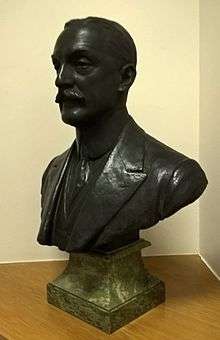Robert Hadfield
Sir Robert Abbott Hadfield, 1st Baronet FRS[1] (28 November 1858 in Sheffield – 30 September 1940 in Surrey) was an English metallurgist, noted for his 1882 discovery of manganese steel, one of the first steel alloys. He also invented silicon steel, initially for mechanical properties (patents in 1886) which have made the alloy a material of choice for springs and some fine blades, though it has also become important in electrical applications for its magnetic behaviour.[2]
Sir Robert Hadfield, Bt | |
|---|---|
 Bust in the Sir Robert Hadfield Building, University of Sheffield | |
| Born | 28 November 1858 |
| Died | 30 September 1940 (aged 81) |
| Nationality | United Kingdom |
| Occupation | Engineer |
| Engineering career | |
| Projects |
|
| Awards |
|
Life
Hadfield was born 28 November 1858 in Sheffield. Hadfield's father, also named Robert Hadfield, owned Hadfield's Steel Foundry in Sheffield and was one of the first manufacturers of steel castings. The younger Hadfield took over the business in 1888 and built the firm into one of the largest foundries in the world. Between 1898 and 1939 he lived at Parkhead House in Whirlow, Sheffield. He published over 200 papers on his metallurgical research.
In the 1930s he employed record breaking motorcyclist Florence Blenkiron as a secretary[3] and office manager.[4]
He died 30 September 1940 in Surrey.[2]
Honours

In 1899, Hadfield was made Master Cutler.[5] He was knighted on 21 July 1908[6] and created a baronet, of Sheffield in the West Riding of the County of York on 26 June[7] 1917. He was elected as a Fellow of the Royal Society in 1909,[1] a member of the Royal Swedish Academy of Sciences in 1912 and an honorary member of the Academy of Sciences of the USSR in 1933.[8] In 1939 he was awarded the Freedom of the City of Sheffield.[5]
He was awarded a Telford Medal by the Institution of Civil Engineers in 1888, the John Scott Medal of The Franklin Institute in 1891 and the Bessemer Gold Medal in 1904.[9] He received the John Fritz Medal in 1921 and the Albert Medal (RSA) in 1935, both for his contributions to metallurgy.
He is commemorated in the Sir Robert Hadfield Building at the University of Sheffield, which contains the Departments of Materials Science and Engineering and Chemical and Biological Engineering. There is also a wing at the Northern General Hospital named after him.
References
- Desch, C. H. (1941). "Robert Abbott Hadfield. 1858–1940". Obituary Notices of Fellows of the Royal Society. 3 (10): 647–664. doi:10.1098/rsbm.1941.0027.
- Tweedale, Geoffrey (November 1985). "Sir Robert Abbott Hadfield F.R.S. (1858–1940), and the Discovery of Manganese Steel". Notes and Records of the Royal Society of London. 40 (1): 63–74. doi:10.1098/rsnr.1985.0004.
- "Leeds Mercury". 27 June 1935.
- Wallach, Theresa (2011). The Rugged Road. ISBN 978-0-9564975-2-9.
- River Sheaf Robert Hadfield 1858–1940
- "No. 28162". The London Gazette. 28 July 1908. p. 5530.
- "No. 30224". The London Gazette. 10 August 1917. p. 8130.
- The big encyclopaedic dictionary (in Russian)
- H. M. Cobb (2012) "Dictionary of Metals" (ASM International) p 308
Further reading
- Greenaway, Frank (1970–1980). "Hadfield, Robert Abbott". Dictionary of Scientific Biography. 6. New York: Charles Scribner's Sons. p. 5. ISBN 978-0-684-10114-9.